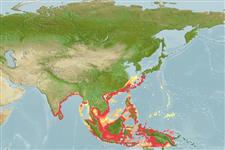Issue
Genus Eschmeyer, pers. comm.
Environment: milieu / climate zone / depth range / distribution range
Οικολογία
Θαλασσινό(ά); Υφάλμυρο βενθικό(ς); αμφίδρομο (Ref. 51243); εύρος βάθους 16 - 73 m (Ref. 57343). Tropical; 37°N - 11°S, 75°E - 149°E
Eastern Indian Ocean and Western Pacific: southwestern India to Papua New Guinea, north to Japan. May rarely occur in the Philippines, eastern Indonesia, and Papua New Guinea (Ref. 57343). Not in Red Sea (Ref. 84159).
Μέγεθος / Βάρος / Age
Maturity: Lm ? range ? - ? cm
Max length : 30.0 cm TL αρσενικό/απροσδιόριστο; (Ref. 30573); common length : 20.0 cm TL αρσενικό/απροσδιόριστο; (Ref. 30573)
Ραχιαίες άκανθες (συνολικά) : 9; Μαλακές ραχιαίες ακτίνες (συνολικά) : 12 - 13; Εδρικές άκανθες: 3; Μαλακές εδρικές ακτίνες: 11 - 13; Σπόνδυλοι: 24. With 6 pectoral filaments; uppermost not reaching posterior tip of pectoral fin. Pectoral fin, rays moderate, 19-25% of SL; all rays branched except uppermost 1 or 2. Second dorsal spine short, 5-8% of SL. Atrophied swim bladder, like a string. A large black spot anteriorly on lateral line (Ref. 40958, 41110). No upper lip; lower lip well-developed except at symphysis. Operculum broadly rounded; preoperculum coarsely serrated. Color is golden-olive above ,silvery below. A large oval blotch is at the start of the lateral line (Ref. 561).
A marine species found on sandy and muddy bottoms of the continental shelf (Ref. 4340, 11230, 57343). Frequently enters estuaries (Ref. 9685, 11230). Feeds mainly on small crustaceans (especially shrimps), fishes and benthic organisms; also on sponges and fish scales (Ref. 9685). The progression in this hermaphrodite is protandrous, changing from a juvenile to a hermaphrodite, then a female (Ref. 9685).
Life cycle and mating behavior
Maturities | Αναπαραγωγή | Spawnings | Egg(s) | Fecundities | Προνύμφες
Motomura, H., 2004. Threadfins of the world (Family Polynemidae). An annotated and illustrated catalogue of polynemid species known to date. FAO Spec. Cat. Fish. Purp. Rome: FAO. 3:117 p. (Ref. 57343)
IUCN Red List Status (Ref. 130435)
Threat to humans
Harmless
Human uses
αλιεία: Εμπορικό(ά); αλιεία αναψυχής: ναί
Εργαλεία
Special reports
Download XML
Διαδικτυακές πηγές
Estimates based on models
Preferred temperature (Ref.
123201): 23.5 - 28.4, mean 27.7 °C (based on 227 cells).
Phylogenetic diversity index (Ref.
82804): PD
50 = 0.5000 [Uniqueness, from 0.5 = low to 2.0 = high].
Bayesian length-weight: a=0.01479 (0.00929 - 0.02354), b=3.04 (2.91 - 3.17), in cm total length, based on LWR estimates for this species & (Sub)family-body (Ref.
93245).
Τροφικό Επίπεδο (Ref.
69278): 3.8 ±0.57 se; based on food items.
Generation time: 3.0 ( na - na) years. Estimated as median ln(3)/K based on 1
growth studies.
Ελαστικότητα (Ref.
120179): Μεσαίο(α), ελάχιστος χρόνος για διπλασιασμό πληθυσμού 1,4 - 4,4 έτη (Preliminary K or Fecundity.).
Fishing Vulnerability (Ref.
59153): Low to moderate vulnerability (31 of 100).
